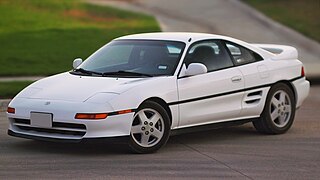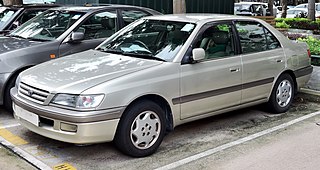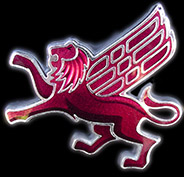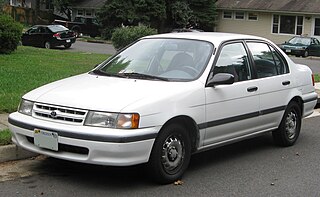Related Research Articles

The Toyota Celica or is an automobile produced by Toyota from 1970 to 2006. The Celica name derives from the Latin word coelica meaning "heavenly" or "celestial". In Japan, the Celica was exclusive to the Toyota Corolla Store dealer chain.

The Toyota Supra is a sports car and grand tourer manufactured by Toyota Motor Corporation beginning in 1978. The name "supra" is derived from the Latin prefix, meaning "above", "to surpass" or "go beyond".

The AE86 series of the Toyota Corolla Levin and Toyota Sprinter Trueno are small, front-engine/rear-wheel-drive models within the front-engine/front-wheel-drive fifth generation Corolla (E80) range — marketed by Toyota from 1983 to 1987 in coupé and liftback configurations.

The Toyota MR2 is a line of two-seat, mid-engined, rear-wheel-drive sports cars manufactured in Japan and marketed globally by Toyota from 1984 to 2007 over three generations: W10 (1984–1989), W20 (1990–1999) and W30 (2000–2007). It is Japan's first rear mid-engined production car.

The Toyota Corona is an automobile manufactured by the Japanese automaker Toyota through ten generations between 1957 and 2001. It was replaced in Japan by the Toyota Premio, It was replaced in Europe by the Toyota Avensis and it was replaced in Asia-Pacific/Americas by the Toyota Camry. It was related to Toyota Mark II and Toyota Carina. Traditionally, the competitor from Datsun/Nissan was the Datsun/Nissan Bluebird. The word "corona" is Latin for "crown", a reference to an earlier vehicle Toyota offered called the Toyota Crown. It was exclusive to Toyopet Store dealership channels in Japan, while the larger Crown was available only at Toyota Store locations.

The Toyota Soarer is a personal luxury GT coupé produced from 1981 to 2005 by Toyota and sold in Japan. It was available at both Japanese Toyota dealerships called Toyota Store and Toyopet Store, and it debuted with the Z10 series, replacing the Toyopet Store exclusive Mark II coupé, and the Toyota Store exclusive Crown coupé.
Toyota Variable Induction System, or T-VIS, is a variable intake system designed by Toyota to improve the low-end performance of multi-valve engines.

The Toyota Chaser is a mid-size car produced by Toyota in Japan. Most Chasers are four-door sedans and hardtop sedans; a two-door hardtop coupé was available on the first generation only. It was introduced on the 1976 Toyota Corona Mark II platform, and was sold new by Toyota at Toyota Vista Store dealerships only in Japan, together with the Toyota Cresta.

The Toyota Motor Corporation G-family engine is a family of straight-6 piston engines produced from 1979 to 2006. It is notable in that only a single displacement, 2.0 L (1,988 cc), was produced in this series. All were belt-driven OHC non-interference engines, with multivalve DOHC and even variable valve timing added later. The 1G-GEU was Toyota's first four-valve twincam engine. A prototype version of the 1G-GEU called the LASREα–X, featuring twin-turbos, variable valve timing and intake as well as variable displacement, was fitted to the Toyota FX-1 show car at the 1983 Tokyo Motor Show. It showcased a number of technologies which were later to become commonplace.

The Toyota Mark II is a compact, later mid-size sedan manufactured and marketed in Japan by Toyota between 1968 and 2004. Prior to 1972, the model was marketed as the Toyota Corona Mark II. In some export markets, Toyota marketed the vehicle as the Toyota Cressida between 1976 and 1992 across four generations. Toyota replaced the rear-wheel-drive Cressida in North America with the front-wheel-drive Avalon. Every Mark II and Cressida was manufactured at the Motomachi plant at Toyota, Aichi, Japan from September 1968 to October 1993, and later at Toyota Motor Kyushu's Miyata plant from December 1992 to October 2000, with some models also assembled in Jakarta, Indonesia as the Cressida.

The Toyota Tercel is a subcompact car manufactured by Toyota from 1978 to 1999 across five generations, in five body configurations sized between the Corolla and the Starlet. Manufactured at the Takaoka plant in Toyota City, Japan, and sharing its platform with the Cynos and the Starlet, the Tercel was marketed variously as the Toyota Corolla II — sold at Toyota Japanese dealerships called Toyota Corolla Stores — and was replaced by the Platz in 1999. It was also known as the Toyota Corsa and sold at Toyopet Store locations. Starting with the second generation, the Tercel dealership network was changed to Vista Store, as its badge engineered sibling, the Corolla II, was exclusive to Corolla Store locations.
Air suspension is a type of vehicle suspension powered by an electric or engine-driven air pump or compressor. This compressor pumps the air into a flexible bellows, usually made from textile-reinforced rubber. Unlike hydropneumatic suspension, which offers many similar features, air suspension does not use pressurized liquid, but pressurized air. The air pressure inflates the bellows, and raises the chassis from the axle.

The Toyota Crown is an automobile which has been produced by Toyota in Japan since 1955. It is currently a line of executive sedans primarily aimed at the Japanese market and sold in other Asian markets.

The Isuzu Florian is an intermediate class car manufactured by Isuzu Motors Ltd. in Japan from November 1967 to 1983. The Florian's body remained essentially the same through its unusually long life cycle, being afforded only two moderate facelifts. The Isuzu Florian was originally presented as the Ghia Isuzu 117 Sedan at the 1966 Tokyo Motor Show and shared its complete chassis with the closely related Isuzu 117 Coupé. Originally available only with a 1.6 liter gasoline inline-four engine producing 84 PS (62 kW) at 5200 rpm, a 1.8 liter version was later added as was a diesel option, first seen in 1977.
The Mitsubishi HSR is a range of concept cars exhibited by Mitsubishi Motors through the late 1980s and 1990s. There were six distinct iterations of the vehicle released biannually to coincide with the Tokyo Motor Show, with each model after the original identified by a Roman numeral suffixed to the name. The meaning of the acronym varied over the years. The first iteration meant Hi-speed Running Research, the second Hi-Sophisticated Research, and the third Human Science Research.
Toyota concept vehicles produced between 1935 and 1969 include:
Toyota Concept Vehicles produced between 1980 and 1989 include:
TEMS is a shock absorber that is electronically controlled based on multiple factors, and was built and exclusively used by Toyota for selected products during the 1980s and 1990s. The semi-active suspension system was widely used on luxury and top sport trim packages on most of Toyota’s products sold internationally. Its popularity fell after the “bubble economy” as it was seen as an unnecessary expense to purchase and maintain, and remained in use on luxury or high performance sports cars.
References
- ↑ All About the Toyota Twin Cam (2nd ed.). Tokyo, Japan: Toyota. November 1984. p. 18. Retrieved 2019-04-25.
- ↑ Reingold, Edwin M.; Martin, Charles L. (1983-11-14). "Tokyo's Wonder Cars". TIME.COM. Archived from the original on February 20, 2008. Retrieved 2009-08-19.
- ↑ Waddell, Richard; Bird, Jon (March 1985). "A short hop to put flashy concepts on the road - Tokyo Motor Show". Ward's Auto World. Archived from the original on 2004-12-08. Retrieved 2009-08-19.
- ↑ All About the Toyota Twin Cam (2nd ed.). Tokyo, Japan: Toyota. November 1984. p. 19. Retrieved 2019-04-25.
Information copied from an English language brochure given out by Toyota at the 1984 Geneva Motor Show. A Japanese-language version of the same brochure was given out at the 1983 Tokyo Motor Show.